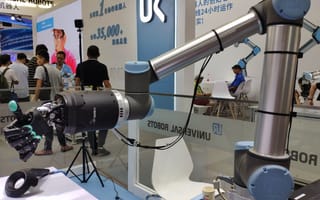The World Robot Conference, held in Beijing, China, showcased the latest bionic embodiments of artificial intelligence capable of everything from shooting hoops and serving craft coffee to painting portraits and kneading out muscle knots.
In its eighth year, the seven-day convention welcomed 600 exhibitors and 812,000 attendees. The central theme, ‘Open Innovation, Sharing the Future,’ attracted a wide variety of cyborg creations designed to supplement service sectors, automate industrial production and even provide emotional companionship amid rising loneliness levels.
Check out some of the wildest picks from this year’s robo-fest, coming to a factory, restaurant or living room near you.
Cyborg Cats by Elephant Robotics
Elephant Robotics showcased a clowder of touch-responsive robo-kitties that use AI and deep learning to imitate lifelike movements. They bat toys, meow, purr and “bake bread” (knead). They even ignore commands from time to time, like a real cat would, and walk themselves to their own charging stations. Both the furry, ragdoll-like MetaCat and smooth, hard-plastic MarsCat models are fully programmable, the latter featuring a quad-core Raspberry PI, and emote via eye animation. Cyborg cats may be ideal for those seeking an allergy-free, no-feed or cleanup alternative to feline companionship or living in a residence with pet restrictions.
Ultra-Realistic Humanoids by Ex Robots
Ex Robots pulled out all the stops this year at their booth, which featured an assortment of eerily realistic humanoids. A red-tuxedo-ed bartender greeted passersby as three bots clad in skin-tight neon outfits gestured and swayed in the background while a robotic head of ancient philosopher Confucius looked on from a wall mount. This latest rollout of Ex Robots’ technology incorporates supermotors that allow unified control at each joint. New upgrades also include vision, skin and haptics, which work together to create more natural micro-expressions.
Bipedal Droid CyberOne by Xiaomi
CyberOne made its debut about a year ago, and has since been under development. The nearly six-foot-tall bipedal humanoid’s most impressive feature is its ability to walk on two legs. Each of its 13 joints enjoy 21 degrees of freedom, which allows the machine to maintain posture and balance as it shuffles around. From its organic, light-emitting diode (OLED) display screen, CyberOne can detect 45 different human emotions and 85 types of background noises using an AI interaction algorithm.
Festo’s Bionic Butterflies
German automation company Festo has developed lightweight flying objects that can exhibit collective behavior in its blue-winged butterflies that weigh 42 grams with a 68-centimeter wingspan and use infrared cameras, GPS and an intelligent networking system to navigate the airways. These artificial insects, dubbed eMotionButterflies, can control each wing individually and may serve a practical use transporting material within factories, according to the company’s website.
Intuitive’s da Vinci Surgical System
The da Vinci surgical system earned FDA approval in 2000 shortly after its debut. Today, in its fourth generation, surgeons operate side-by-side with these machines to perform a range of procedures from a single port. In many cases, robot-assisted surgery has become a preferred method. In fact, an estimated three out of four prostate cancer surgeries in the U.S. are performed through a da Vinci system, according to the University of Colorado Health. From its four arachnid-like limbs, hanging down over a patient, the robo-surgeon’s metal probes are fitted with necessary instruments guided by a surgeon from a remote console. Visualization is provided by an endoscopic camera. Its proprietary technology allows for seven-degrees-of-freedom maneuvering — something not possible with a human wrist. With just a few small incisions, the system increases vision, precision, dexterity and control in modern-day operating rooms.
Harvest Bots by K2 Tech
On display, K2 Tech’s precision farming robots picked a cherry tomato every three to six seconds. Enhanced with AI, the robotic arm relies on a vision system that can “see” each piece of fruit in real time in order to determine if it’s ripe for picking, which is assessed by its shape, color and size. This system also weeds out produce afflicted by diseases and pests. The China-based company is building an arsenal of smart farming machinery — capable of seeding, weeding, harvesting, collecting crop data and sampling soil — in order to automate the agricultural sector.
Unitree’s Robo-dogs
Unitree debuted the latest model in its robo-dog pack, Go2, a 30-pound mechanical quadruped capable of traversing complex terrain and running 18 kilometers per hour. Equipped with an ultra-long-life battery and a 28.8 voltage capacity, this dog-droid uses automatic code generation using ChatGPT to intelligently respond to commands, including shake, dance, do a handstand and take a photo. Its most prominent feature is the 4D LiDAR sensor located where a pup’s snout would be. This 360-degree camera creates a real-time map of its immediate surroundings by sending out a pulsing light, which bounces off proximal objects and surfaces, then detecting their range in the time it takes for the light beams to reflect back. This way, the bionic good boys avoid bumping into obstacles.




